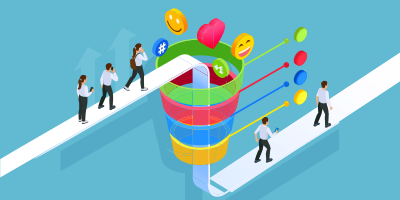B2B SaaS Lead Generation
B2B SaaS Lead Generation Guide
Lead generation entails proactively identifying and nurturing potential prospects to drive new customer acquisition. The software-as-a-service (SaaS) industry has seen tremendous growth in recent years. According to Gartner, the worldwide public cloud services market is forecast to grow 17% in 2021 to $332.3 billion, up from $282.5 billion in 2020.
However, the increasing number of SaaS companies also means more competition for potential customers. Standing out requires robust lead-generation strategies to identify and engage high-intent prospects before competitors do.

- Increased sales velocity by providing sales teams with more ready-to-convert leads
- Reduced customer acquisition costs by capturing prospects early in the buying journey
- Expanded reach beyond existing customer networks to fuel growth
- Better alignment between sales and marketing through shared lead metrics
- Higher return on marketing investment by tracking leads to customer conversion rates
Developing a B2B SaaS Lead Generation Strategy
An effective lead generation strategy for SaaS companies rests on four pillars:
1. Identifying Total Addressable Market (TAM)
The first step is analyzing the total addressable market (TAM) – the overall revenue opportunity based on target customer profiles and buying potential.
This involves:
- Defining ideal customer profiles (ICP) – target titles, industries, company sizes, pain points, etc.
- Estimating the number of potential prospects matching the ICPs
- Researching typical deal sizes and sales cycles for these prospects
- Calculating the total potential recurring revenue from this target market
2. Multi-Channel Lead Generation
Today’s B2B buyers engage across many touchpoints during their research process. A presence across channels improves visibility and expands reach.
Key channels SaaS companies should leverage include:
- Organic search: Appearing on the first page for relevant queries is critical for discovery. SEO also delivers highly qualified traffic.
- Paid search – PPC ads on Google and Bing allow targeting prospects actively searching for solutions.
- Social media – An active presence establishes thought leadership and brand visibility.
- Email marketing – One of the most effective channels for lead nurturing based on interests and engagement.
- Content marketing: Informative assets like ebooks, case studies, and videos convert prospects during the education stage.
- Website optimization: Clear value propositions, conversion-focused pages, and smart forms improve conversions.
3. Lead Scoring Framework
With multiple lead sources, it’s essential to identify high-potential prospects objectively. Lead scoring models rate leads based on engagement, profile fit, and interest levels.
Typical lead scoring criteria for B2B SaaS include:
- Demographic fit: Industry, title, company size, etc. based on ICPs
- Behavior: Page views, content downloads, email opens/clicks
- Form completions: High-intent actions like inquiries, demos, trials
- Firmographics: Employee count, tech budget/spend signals
- Technographics: Use of current solutions, tech stack fit
Scores determine sales priority and nurturing tactics. Sales teammates also add subjective assessments to the mix.
4. Conversion Optimization
Attracting leads is only the first step. Prospects must successfully move through the sales funnel to hit revenue goals.
Optimization focuses on improving conversions at every stage
- Landing pages: Clear value proposition, focused CTAs, frictionless forms
- Demo scheduling: Easy online booking, calendar integrations, email/text reminders
- Free trials: Intuitive onboarding, proactive engagement during evaluation
- Pricing and proposals: Customized packaging and payment options
- Contact sales follow-up: Persistent nurturing of prospects showing intent
B2B SaaS Lead Generation Tactics and Execution
We’ve covered the key strategy elements. Now let’s explore proven lead generation tactics to attract and nurture prospects:
SEO for SaaS Lead Generation
Search engine optimization (SEO) helps SaaS companies get found organically by potential customers. Key optimization areas include:
- Keyword research: Identify high-value search terms prospects use during research. Tools like Google Keyword Planner, SEMrush, and Ahrefs are invaluable.
- Content optimization: Optimize pages and content for target keywords, ensuring excellent user experience.
- Technical SEO: Site speed, mobile optimization, SSL, sitemaps, structured data, and the robots.txt file are foundational.
- Link building: Earn high-authority external links using outreach, guest posting, partnerships, etc.
- Local SEO: For SaaS companies with regional markets, optimize for searches, including city names and “near me” keywords.
- Voice search optimization: Optimize for voice queries using natural long-tail keywords.
Tools like Google Search Console, SEMrush, and Moz provide data to refine keywords and improve rankings over time.
PPC Ads for SaaS Lead Gen
Pay-per-click (PPC) ads put your brand in front of prospects actively searching for solutions:
- Google Ads: The largest PPC platform. Optimized ad copy, landing pages, bids, and negative keywords are key.
- Microsoft Advertising: Great for targeting business decision-makers on Bing, MSN, and LinkedIn.
- Retargeting: Remarket to past visitors across sites and social media to re-engage them.
- LinkedIn ads: Sponsored content and Sponsored email enable extremely targeted outreach on this professional network.
- Amazon Ads: Product and Sponsored Brand campaigns reach buyers where they shop.
- Intent-based segmentation: Separate ad groups for each stage, such as research, evaluation, trials, etc.
- Audience targeting: Use buyer persona demographics, technographics, and firmographics for relevance.
Social Media Marketing
An active presence on key social platforms increases brand awareness and interactions with prospects:
- Thought leadership content: Share valuable insights, trends, and best practices.
- Social listening: Monitor relevant conversations and participate tactfully.
- Paid promotions: Amplify engagement with promoted posts and ads.
- Community building: Build loyal followers through consistently engaging content.
- Hashtag marketing: Grow visibility for brand and solution-related hashtags.
- Influencer engagement: Collaborate with industry experts for reviews and co-creation.
- Lead generation ads: Run conversion-optimized ads linked to landing pages and forms.
- Audience expansion: Use lookalike modeling to extend reach with similar profiles.
Account-Based Marketing (ABM)
Account-based marketing focuses on personalized outreach to high-value target accounts identified through ideal customer profiling:
- Account selection: Identify priority companies with the highest potential deal value.
- Lead identification: Surface relevant contacts and influencers within target accounts.
- Customized campaigns: Tailor messaging specifically to each company and its challenges.
- Account-based advertising: Serve highly targeted ads to key decision-makers within accounts across channels.
- Personalized nurturing: Send tailored content and messages based on individuals’ interests.
- Multi-touch attribution: Track engagement across tactics to optimize spend.
- Expanded thresholds: Provide enough budget and time for extended sales cycles.
B2B Content Marketing
Quality content establishes subject matter expertise and provides value to prospects during their buyer’s journey:
- Buyer persona research: Create content tailored to inform and engage each of your core personas.
- Blog: Publish in-depth articles on industry trends, product capabilities, common use cases, and other topics prospects care about.
- eBooks / Guides: Long-form content like manuals and handbooks to educate prospects.
- Videos: Demonstrations, testimonials, explainers, and other instructional videos.
- Webinars / Events: Share insights while capturing registrations to build your audience.
- Case Studies: Stories demonstrating your solution’s value increase credibility.
- Analyst Reports: Independent endorsements and reviews build trust.
- Newsjacking: Timely commentary on current events related to your market.
- Interactive Tools: Calculators, assessments, quizzes, etc., that provide value and generate leads.
Website Optimization
Your website is the digital hub that brings together all lead-generation efforts. Optimization focuses on:
- Messaging and copy: Clearly convey value propositions, differentiators, and benefits on each page.
- Layout and navigation: Intuitive IA ensures prospects can self-navigate to find solutions.
- Forms: Minimize fields and friction to maximize conversions.
- Calls-to-action (CTAs): Use action-driving language and contrasting colors for clicks.
- Page speed: Faster load times improve engagement and SEO.
- Responsiveness: Mobile optimization is critical with responsive design.
- Chatbots: Automated conversations provide quick answers to common questions.
Email Marketing and Automation
Email continues to deliver the highest ROI across digital channels for lead nurturing:
- Lead capture forms: Offer exclusive content in exchange for work emails.
- Behavioral segmentation: Send emails based on interests and actions.
- Drip campaigns: Pre-defined nurturing sequences with relevant content.
- Personalization: Dynamic content with prospect names, company, role, etc.
- Subject line testing: Compare open rates for multiple versions.
- Lead scoring: Advance contacts to sales-ready based on engagement.
- Spam monitoring: Analyze unsubscribes, abuse reports, and blocked emails.
Partnerships and Referrals
Partnerships with complementary solutions provide access to each other’s customer base:
- Technology partnerships: Joint solutions and integrations expand capabilities.
- Channel partnerships: Reseller programs and sales enablement.
- Affiliate marketing: Promotions and commissions for referrals.
- Advocacy groups: Participate in industry groups and associations.
- Referral programs: Provide incentives to customers for introductions and testimonials.
Optimizing Lead Management and Sales Processes
To scale growth efficiently, sales and marketing teams must work collaboratively with integrated systems and processes to nurture and convert leads.
Key elements for optimized lead management include:
Marketing and Sales Alignment
The best results come when both teams share lead-generation goals and metrics. Marketing focuses on delivering qualified leads, while sales concentrates on conversion:
- Shared KPIs: Volume, cost per lead, sales cycle length, win rates, etc.
- Service level agreements (SLAs): Define standards for lead qualification before handoff to sales.
- Mapping lead flows: Visualize cross-team lead processes and identify gaps.
- Technology integration: Unified CRM and MA systems for seamless workflows.
- Closed-loop reporting: Track leads from generation to close to attribute ROI accurately.
Lead Routing with Specialized Follow-Up
Segment leads based on profile, behavior, and readiness to route efficiently:
- Sales development reps (SDRs): Handle inbound leads and outbound prospecting for pipeline generation.
- Account executives (AEs): Focus on advancing leads that show purchase signals.
- Channel partners: Pass low-priority leads to resellers for additional coverage.
- Customer success: Upsells and renewals offset churn from existing accounts.
CRM Integration
Integrating your CRM with marketing automation and other MarTech enables:
- Centralized data: All prospect and customer information in one place.
- Automated workflows: Smooth handoffs between teams and systems.
- Lead and deal tracking: Holistic visibility from lead to close.
- Communication history: Conversations across channels available for reference.
- Analytics: Reporting on multi-channel campaign performance and bottlenecks.
Conversion Rate Optimization (CRO)
CRO focuses on maximizing prospect conversions at each funnel stage:
- Landing pages: Align page messaging with channel source and campaign.
- Contact forms: Reduce fields and use smart technology like Gravity Forms.
- Demo scheduling: Simplify booking with calendar integrations and reminders.
- Trials: Make signup easy while educating prospects on product value.
- Product packaging/pricing: Provide flexible options aligned to differing needs.
- Payment and fulfillment: Minimize steps and offer digital/automated options.
Why Outsource B2B SaaS Lead Generation?
For fast-growing SaaS firms, building an in-house lead generation team can be challenging:
- Requires specific digital marketing and sales expertise
- Identifying and nurturing prospects is time-intensive
- Maintaining extensive toolsets and systems is expensive
- Hard to scale tactics and headcount rapidly as needed
- Proven Expertise: Deep experience fueling growth for SaaS companies specifically. Stay updated on the latest trends and tactics.
- Expanded Capabilities: Agencies integrate end-to-end services, such as SEM, SEO, PPC, email marketing, content creation, events, etc. It is difficult for in-house teams to match reach.
- Technology and Infrastructure: Agencies maintain extensive stacks, including marketing automation, CRM, analytics, data orchestration, and more. Significant investment is needed in-house.
- Flexible Scaling: Agencies can rapidly add headcount and expand campaigns to meet changing demand, which is difficult to do with internal teams.
- Performance-Based Pricing: You only pay for actual leads delivered, aligned to your volume and quality goals. Share risk.
- Speed and Efficiency: Get access to proven processes and best practices refined across clients—no need to reinvent the wheel.
- Improved Sales and Marketing Alignment: Agencies act as objective partners, coordinating between sales and marketing teams and systems.
- Faster Time-to-Value: Launch comprehensive campaigns in weeks rather than months it takes to build in-house.
The inherent advantages of specialized agencies enable B2B SaaS companies to accelerate pipeline growth and achieve revenue targets more quickly and cost-effectively than going solo.
Key Considerations for Choosing a SaaS Lead Generation Agency
Not all agencies are created equal. Here are important criteria to evaluate prospective partners:
- Industry specialization: Domain expertise in your specific market provides inherent value.
- B2B focus: Avoid agencies with mainly B2C experience. B2B campaigns differ significantly.
- Technical expertise: Look for demonstrated experience in marketing SaaS and digital products.
- Lead qualification processes: Do they profile, score, and nurture leads before sales handoff?
- CRM integration: Can they sync with your sales systems and workflows?
- Analytics and reporting: Can they track granular KPIs and attribution models?
- Customer success philosophy: Are they invested in long-term value beyond quick wins?
- Transparency: Will they share details about strategies, campaigns, budgets, and reporting?
- Strategic thinking: Do they offer ideas and frameworks beyond just execution?
- Cultural fit: Look for shared work styles, communication norms, and values.
- Pricing model: Prefer performance-based over large upfront contracts.
Why Choose XtremeUX as Your B2B SaaS Lead Generation Agency
When evaluating prospective lead generation agency partners, XtremeUX stands out as the premier choice for B2B SaaS organizations.
Here are key reasons numerous high-growth software companies trust us:
Fully Specialized B2B SaaS Expertise
Our team lives and breathes the SaaS space. We partner closely with software companies across segments like sales tech, marketing tech, security, analytics, cloud platforms, SMB software, and more.
A deep understanding of buyer journeys, pain points, and value drivers in these verticals informs our proven playbooks. Target personas, messaging frameworks, and outreach campaigns are tailored specifically to SaaS.
This focused expertise provides inherent advantages over generalist agencies in attracting relevant prospects.
Integrated Full-Funnel Services
We handle everything from TOFU to BOFU: top-of-funnel lead generation to bottom-of-funnel sales enablement.
Our work encompasses:
- Target persona research
- Multi-channel campaigns: SEO, PPC, email, content marketing, social media
- Campaign strategy, execution, and optimization
- Performance reporting and analytics
- Technology integrations: CRM, MA, chat, analytics
- Sales enablement consulting
Scalable and Flexible Delivery
Our team of 60+ marketing and sales experts can rapidly scale lead-generation programs aligned with your growth plans.
We seamlessly adjust tactics, headcount, and spending up or down as your demand cycles fluctuate.
This on-demand flexibility is difficult for in-house teams to match.
Performance-Based Pricing
Our fees directly align with the pipeline and revenue generated, with no long-term commitments required. You only pay for confirmed sales opportunities sourced by the campaigns.
In effect, we share the risk and are incentivized to over-deliver results.
Proven B2B Technology Stack
We leverage top B2B marketing and sales technologies optimized for SaaS clients:
- CRM: Salesforce, HubSpot, Pipedrive
- Marketing Automation: Marketo, Eloqua, Pardot
- Analytics: Google Analytics 360, Mixpanel, Heap, Funnel.io
- Attribution: Bridge by Leadspace, LeadsRx
- AdTech: Google Marketing Platform, Acquisio
200+ Proven SaaS Client Success Stories
With hundreds of successful SaaS partnerships under our belt, we have an unmatched track record in the space.
Software clients consistently achieve 2-3x growth in qualified opportunities within months of partnering with us.
Our case studies and client testimonials validate our ability to deliver transformative pipeline growth for SaaS companies.
More Lead Generation
What Our Clients Say
"XtremeUX took our digital marketing to the next level. Their paid search campaigns resulted in a 20% increase in leads month-over-month!"

Jane Doe
CEO, Construction Company
"We've worked with several agencies in the past, but none could match the expertise and results of the team at XtremeUX. Our revenue from digital channels has doubled since partnering with them."

John Smith
Marketing Director, Automation Industries

Lisa Johnson
Ecommerce Manager, Furniture Store

Jessica Wu
VP Marketing, Home Decor Store

Michael Rogers
Founder, Dental Clinic


